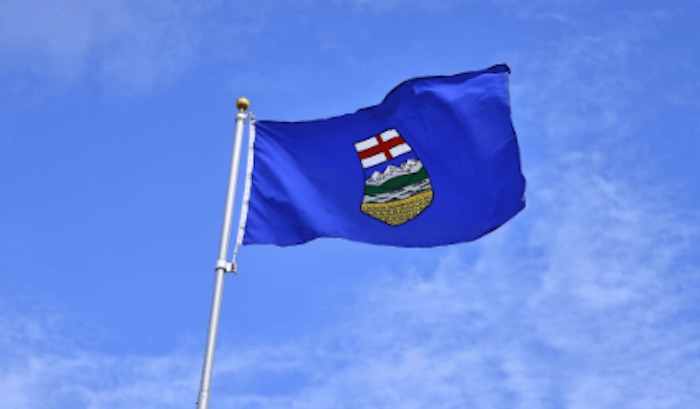Alberta
IN CASE OF EMERGENCY, READ THIS! ALBERTA’S COVID-19 REPORT

From the Frontier Centre for Public Policy
By Barry Cooper
The report calls for emergency management experts – not doctors or health care bureaucrats – to be in charge when such disasters strike, with politicians who are accountable to the people making the key decisions. Most important, the report demands much stronger protection for the individual freedoms that panic-stricken governments and overbearing professional organizations so readily quashed.
Nobody needs reminding that the Covid-19 pandemic – and the official responses to it – left hardly a person, group or country unaffected. From the lost learning of school closures to the crushed businesses and ruined lives, to the recurring social separation, to the physical toll itself, the wreckage came to resemble recession, social disintegration, war and the ravages of disease all in one. Yet the governments and organizations that designed and oversaw the emergency’s “management” have proved decidedly incurious about delving into whether they actually did a good job of it: what went right, what went wrong, who was responsible for which concepts and policies, who told the truth and who didn’t, and what might be done better next time. Few countries are performing any such formal evaluation (the UK and Sweden being prominent exceptions).
In Canada, the Justin Trudeau government has rebuffed calls for a public inquiry (perhaps a small mercy, as it is hard to envision this prime minister not politicizing such an exercise). Nearly every Canadian province is also ignoring the matter. The sole exception is Alberta, which in January created the Public Health Emergencies Governance Review Panel to, as its terms of reference state, “review the legislation and governance practices typically used by the Government of Alberta during the management of public health emergencies and other emergencies to recommend changes which, in the view of the Panel, are necessary to improve the Government of Alberta’s response to future emergencies.” The Panel’s inquiry fulfilled a promise made by Premier Danielle Smith when she was running for the leadership of the United Conservative Party.
These terms of reference need to be understood because they greatly influenced what followed – both the restrictions on the Review Panel’s inquiries and the broad scope of its recommendations, released in a densely written Final Report (367 pages including appendices) on November 15. The Panel was chaired by Preston Manning, Leader of the Official Opposition in Ottawa some 25 years ago but who more recently became a prominent voice of skepticism regarding the pandemic response, particularly the dismissive treatment of Canadians’ rights and liberties. With this report Manning has driven and led not one but two major pandemic-related reviews, as he was also central in the non-governmental National Citizens Inquiry on Canada’s Response to the Pandemic, which heard wrenching personal testimony.
Despite working under limitations, Manning and his colleagues have rendered valuable and, indeed, unparalleled public services with each effort. Here one must note whom Manning requested for Alberta’s Review Panel. They are in alphabetical order: Martha Fulford, an academic pediatrician at McMaster University with numerous scholarly articles to her credit; Michel Kelly-Gagnon, a businessman and President Emeritus of the Montreal Economic Institute; John C. Major, a former Justice of the Supreme Court of Canada; Jack Mintz, arguably Canada’s most distinguished living economist; and Rob Tanguay, a Calgary-based clinical psychiatrist specializing in treating addiction, depression and pain. Additional specialists prepared several of the report’s 11 appendices.
This is important because the response of Alberta’s NDP and its left-wing media helpers has been to accuse the Panel of mongering conspiracy theories and attempting to legitimize quack pseudo-science. They are using Manning, the founder and longtime leader of the Reform Party of Canada, as a convenient whipping boy. But they are effectively calling the entire panel – including a former member of the nation’s highest court who stood out for his calm and measured approach – a bunch of nutters if not worse. These critics seem to have emitted not one positive thought about any aspect of the Panel Report. That tells you a great deal about them, including that they probably didn’t even read it.
The report also prompted some balanced to favourable coverage, including from several journalists who previously were pro-lockdown, pro-masking and/or pro-vaccine. Edmonton Sun columnist Lorne Gunter, for example, termed the report “sensible and moderate,” noting that it calls for following “all of the credible science.” Gunter’s use of “all” is significant for, he notes, “a lot of what was pitched to the public as definitive scientific knowledge, such as the vitalness of mask and vaccine mandates, school closures, event cancellations and lockdowns was questioned by solid, reputable scientists (not just streetcorner anti-vaxxers and ‘I did my own research’ social-media experts).” Calgary Herald columnist Don Braid, a habitual UCP critic, also sounded impressed.
Alberta had a thoroughly designed, tested and previously deployed emergency plan. It just chose not to use it against Covid-19. This bizarre and gravely damaging decision has still not been explained.
So what is actually in the report? Chapter 1’s review of the Panel’s purpose notes it was set up to review the procedures Alberta has to respond to “any public emergency, including a public health emergency,” and how its preparations could be improved, including by broadening and deepening “the role of science in coping with future emergencies.” Its purpose was not to criticize Alberta’s actual responses to the Covid-19 event. While the Covid-19 public health emergency was the initial reason the panel was established, its recommendations would apply more broadly. And while science should be considered central to good public policy, science should not be regarded as consisting of a single narrative. Accordingly, “alternative perspectives” (Report, p. 5) should also be considered.
Alberta Emergency Management Agency
The spring 2020 spectacle of wildly shifting statements from public health officials and political leaders, its blizzard of decrees and edicts, proliferating “mandates,” haphazard changes of direction, imposition of seemingly arbitrary rules, public chaos, and sheer aura of panic – sweat-drenched faces, bulging eyes – might lead any citizen to believe that governments had never planned for or faced an emergency. The promiscuous use of “unprecedented” to describe Covid-19 only added to this feeling. In fact, Alberta had a thoroughly designed, tested and previously deployed emergency plan. It just chose not to use it against Covid-19. This bizarre and gravely damaging decision has still not been explained.
The Final Report’s largely overlooked Chapter 2 discusses improvements to the Alberta Emergency Management Agency (AEMA), making it important on several levels. The Panel recommends AEMA be adequately funded and remain the lead agency in dealing with any future emergency, including any future medical emergency. This alone is huge and hugely welcome. To ensure that individuals who are capable of dealing with emergencies and not just apprehended medical crises are in fact in charge, the Panel recommends several legislative changes to the Emergency Management Act and Public Health Act. Even better.
This sound recommendation rests upon the distinction between emergency management and normal policy decisions made by bureaucrats. The original Alberta emergency plan was developed in 2005 to deal with an anticipated influenza pandemic, and was in turn based on planning initiated across North America following the 9/11 terror atrocity. Alberta’s plan was similar to the approach followed by Sweden in 2020, which despite widespread initial condemnation proved highly successful. Its essential feature was that it was written and was to be implemented by individuals who specialize in emergencies, not by individuals with alleged expertise in the specific attributes of an anticipated emergency such as influenza or Covid-19, what the Panel on page 25 refers to as “subject-matter experts” (a more extensive quote is below).
By way of analogy, societies well-prepared to deal with emergencies do not put a limnologist in charge of an emergency response when riverbanks are unexpectedly breached and cause catastrophic flooding. Nor do they scramble to place a vulcanologist in charge when a volcano erupts and threatens lives and livelihoods. The purpose of putting highly trained emergency professionals in the lead during difficult situations is to remove as much as possible the shock effect from the surprises that emergencies typically bring, especially to normal politicians and conventional bureaucrats who expect normalcy to last forever and who panic when it doesn’t.
The emergency plan Alberta had going into 2020 was designed by David Redman, a former senior Canadian Forces officer whose 27 years of service included combat experience, a vocation that typically deals with unexpected surprises. The problem as the pandemic began was not in any lacunae that the Alberta emergency plan may have contained. Rather, as Redman, who at the time was director of Community Programs for Emergency Management (i.e., coordinating local responses), told C2C Journal in an interview in late 2020, “Governments took every plan they had ever written and threw them all out the window. No one followed the process. [The politicians] panicked, put the doctors in charge, and hid for three months.”
Redman was also emphatic on the question of fear, which is inevitably transmitted by panicked officials. He spent countless hours during the pandemic trying to warn every Canadian premier and many federal politicians that discarding emergency management principles and giving healthcare bureaucrats unprecedented authority was dangerous and would likely lead to disaster. Specifically, he urged healthcare officials and politicians to avoid expressing fear. Instead, he sadly noted in an interview with the Western Standard last week, “They used fear as a weapon. In emergency management you never use fear. You use confidence. You show confidence that the emergency can be handled and present a plan to show how this will be achieved.”
The Government of Alberta made a catastrophic and, as said, never-explained mistake when it turned the province over to a narrowly focused, unimaginative career bureaucrat credentialed only with an M.D. To be fair, this was probably too much for any one person, and Chief Medical Officer of Health Deena Hinshaw was placed in a near-impossible position. The consequences of this decision led to the removal of Premier Jason Kenney, and it is also why nearly the first thing his successor did was fire Hinshaw. That is also why the Manning Panel was commissioned.
So let us agree that the Panel’s recommendations to strengthen AEMA would improve emergency management the next time it is needed. That said, the Panel ignored the fact (or at least declined to state) that, had existing procedures been followed in 2020, things would have turned out much better.
Making Proper Use of Science – and Avoiding the Dictatorship of “Experts”
Chapter 3 deals with the place of “science” in public policy. It was self-evident to the Panel that science could help fashion sound public policy responses but could also be used for “political expedience and ideology.” Here the Panel was half-right. On the one hand it advanced a notion of “the scientific method” that dominated science classes a couple of generations ago. According to this account, a researcher develops testable hypotheses that can be modified in light of experimental results. Such was the philosophy of science that I was taught in grade 7 physics.
Its great defect is that it takes no account of what we now call conflicting paradigms or of what German Enlightenment-era philosopher Immanuel Kant called the power of judgment. A pandemic, for example, is not a “fact” but the product of somebody’s judgement. On the other hand, the Panel showed great clarity in asserting that “science is open to the consideration and investigation of alternative hypotheses…and is subject to some degree of uncertainty as an ever-present characteristic of scientific deliberations.” (Report, p. 24)
Before considering how it elaborated the problems of conflicting and alternative hypotheses and of uncertainty, one should note how opponents to both the Panel and UCP government responded to its commonsensical observations. According to NDP Leader Rachel Notley, they were “incredibly irresponsible.” Indeed, she asserted, “What you see is an invitation to normalize conspiracy theories and pseudo-science at the expense of evidence-based medical care.” Notley and CTV went on to attack Premier Smith for embracing “fringe views” – including those found in the October 2020 Great Barrington Declaration, a document written by three of the world’s most respected epidemiologists and subsequently endorsed by, at last count, 939,000 fellow scientists.
One of the Panel-endorsed “fringe views” was that “the number one priority” when a pandemic event is declared should be “protection of the most vulnerable,” (Report, p. 25) which is to say not everybody. Should a particular pandemic’s impact subsequently spread to other social, political and economic relationships, this priority may be modified and adjusted. That sounds eminently responsible, but the NDP wants everybody locked down right from the start.
Still the real question is: who would order the adjustments? The Panel’s answer is forthright, much to the consternation of scientific “experts”: “That a clear and conscious decision be made by elected officials as to the scope of the scientific advice to be sought and that this decision not be left entirely to the subject-matter agency, given that it may have a narrower perspective than that actually required.” (Report, p. 25, emphasis added) As Manning later said: “Political people have to be responsible for the overall direction and management because they’re the people that the public can hold accountable.”
Manning’s determination to avoid having a democracy become a dictatorship of “experts” also reflects a critical aspect of pandemic response: that there are issues far beyond medicine in play, and that the associated decisions are not scientific ones. Weighing risks, for example, is an exercise in logic (a branch of philosophy) and judgment, which depends on inductive reasoning. Assessing costs and benefits of various possible actions is economic in nature. And then, deciding just how much risk to take on and what costs to bear in the pursuit of benefits are questions of ethics. Such things should be undertaken by politicians because, if the people as a whole have a different view of such matters, they can vote in a different government (or, as happened in Alberta, select a decidedly different leader from the same party).
To the experts and their spokespersons, this was an anathema. Lorian Hardcastle, an associate professor in the University of Calgary’s law school and medical school, warned: “We would see ideologically driven response to a public health emergency” that would make it difficult “to keep people alive.” We can characterize the Hardcastle position, which was endorsed strongly during the pandemic by legacy media, the NDP, the “expert” class and the health care bureaucracy, as the “orthodox” doctrine. A health care emergency must be left to the so-called health care experts. Everyone else (including presidents, prime ministers and premiers) should defer to their expertise and do as they are told. The public “conversation” is entirely one-way.
In reality, however, public health does not involve just a single disease but all aspects of the health of a population. Thus, focussing on illness stemming from the SARS-CoV-2 virus was not enough even for so-called specialists because such a focus meant that, for instance, cancer screening was postponed so hospitals would be empty enough to accept the (incorrectly) projected tsunami of Covid-19 patients. Yet cancer is also part of public health, as was the collateral damage from the economic and social effects of lockdowns, school closures and social distancing, none of which the orthodox doctrine considers. Skeptics pointed out all of this throughout the pandemic – and were shouted down as granny-killers.
Alberta
Here’s why city hall should save ‘blanket rezoning’ in Calgary

From the Fraser Institute
By Tegan Hill and Austin Thompson
According to Calgarians for Thoughtful Growth (CFTG)—an organization advocating against “blanket rezoning”— housing would be more affordable if the mayor and council restricted what homes can be built in Calgary and where. But that gets the economics backwards.
Blanket rezoning—a 2024 policy that allowed homebuilders to construct duplexes, townhomes and fourplexes in most neighbourhoods—allowed more homebuilding, giving Calgarians more choice, and put downward pressure on prices. Mayor Farkas and several councillors campaigned on repealing blanket rezoning and on December 15 council will debate a motion that could start that process. As Calgarians debate the city’s housing rules, residents should understand the trade-offs involved.
When CFTG claims that blanket rezoning does “nothing” for affordability, it ignores a large body of economic research showing the opposite.
New homes are only built when they can be sold to willing homebuyers for a profit. Restrictions that limit the range of styles and locations for new homes, or that lock denser housing behind a long, costly and uncertain municipal approval process, inevitably eliminate many of these opportunities. That means fewer new homes are built, which worsens housing scarcity and pushes up prices. This intuitive story is backed up by study after study. An analysis by Canada’s federal housing agency put it simply: “higher residential land use regulation seems to be associated with lower housing affordability.”
CFTG also claims that blanket rezoning merely encourages “speculation” (i.e. buying to sell in the short-term for profit) by investors. Any profitable housing market may invite some speculative activity. But homebuilders and investors can only survive financially if they make homes that families are willing to buy or rent. The many Calgary families who bought or rented a new home enabled by blanket rezoning did so because they felt it was their best available option given its price, amenities and location—not because they were pawns in some speculative game. Calgarians benefit when they are free to choose the type of home and neighbourhood that best suits their family, rather than being constrained by the political whims of city hall.
And CFTG’s claim that blanket rezoning harms municipal finances also warrants scrutiny. More specifically, CFTG suggests that developers do not pay for infrastructure upgrades in established neighbourhoods, but this is simply incorrect. The City of Calgary charges an “Established Area Levy” to cover the cost of water and wastewater upgrades spurred by redevelopment projects—raising $16.5 million in 2024 alone. Builders in the downtown area must pay the “Centre City Levy,” which funds several local services (and generated $2.5 million in 2024).
It’s true that municipal fees on homes in new communities are generally higher, but that reflects the reality that new communities require far more new pipes, roads and facilities than established neighbourhoods.
Redeveloping established areas of the city means more residents can make use of streets, transit and other city services already in place, which is often the most cost-effective way for a city to grow. The City of Calgary’s own analysis finds that redevelopment in established neighbourhoods saves billions of taxpayer dollars on capital and operating costs for city services compared to an alternative scenario where homebuilding is concentrated in new suburban communities.
An honest debate about blanket rezoning ought to acknowledge the advantages this system has in promoting housing choice, housing affordability and the sustainability of municipal finances.
Clearly, many Calgarians felt blanket rezoning was undesirable when they voted for mayoral and council candidates who promised to change Calgary’s zoning rules. However, Calgarians also voted for a mayor who promised that more homes would be built faster, and at affordable prices—something that will be harder to achieve if city hall imposes tighter restrictions on where and what types of homes can be built. This unavoidable tension should be at the heart of the debate.
CFTG is promoting a comforting fairy tale where Calgary can tighten restrictions on homebuilding without limiting supply or driving up prices. In reality, no zoning regime delivers everything at once—greater neighbourhood control inevitably comes at the expense of housing choice and affordability. Calgarians—including the mayor and council—need a clear understanding of the trade-offs.
Alberta
The case for expanding Canada’s energy exports

From the Canadian Energy Centre
For Canada, the path to a stronger economy — and stronger global influence — runs through energy.
That’s the view of David Detomasi, a professor at the Smith School of Business at Queen’s University.
Detomasi, author of Profits and Power: Navigating the Politics and Geopolitics of Oil, argues that there is a moral case for developing Canada’s energy, both for Canadians and the world.
CEC: What does being an energy superpower mean to you?
DD: It means Canada is strong enough to affect the system as a whole by its choices.
There is something really valuable about Canada’s — and Alberta’s — way of producing carbon energy that goes beyond just the monetary rewards.
CEC: You talk about the moral case for developing Canada’s energy. What do you mean?
DD: I think the default assumption in public rhetoric is that the environmental movement is the only voice speaking for the moral betterment of the world. That needs to be challenged.
That public rhetoric is that the act of cultivating a powerful, effective economic engine is somehow wrong or bad, and that efforts to create wealth are somehow morally tainted.
I think that’s dead wrong. Economic growth is morally good, and we should foster it.
Economic growth generates money, and you can’t do anything you want to do in social expenditures without that engine.
Economic growth is critical to doing all the other things we want to do as Canadians, like having a publicly funded health care system or providing transfer payments to less well-off provinces.
Over the last 10 years, many people in Canada came to equate moral leadership with getting off of oil and gas as quickly as possible. I think that is a mistake, and far too narrow.
Instead, I think moral leadership means you play that game, you play it well, and you do it in our interest, in the Canadian way.
We need a solid base of economic prosperity in this country first, and then we can help others.
CEC: Why is it important to expand Canada’s energy trade?
DD: Canada is, and has always been, a trading nation, because we’ve got a lot of geography and not that many people.
If we don’t trade what we have with the outside world, we aren’t going to be able to develop economically, because we don’t have the internal size and capacity.
Historically, most of that trade has been with the United States. Geography and history mean it will always be our primary trade partner.
But the United States clearly can be an unreliable partner. Free and open trade matters more to Canada than it does to the U.S. Indeed, a big chunk of the American people is skeptical of participating in a global trading system.
As the United States perhaps withdraws from the international trading and investment system, there’s room for Canada to reinforce it in places where we can use our resource advantages to build new, stronger relationships.
One of these is Europe, which still imports a lot of gas. We can also build positive relationships with the enormous emerging markets of China and India, both of whom want and will need enormous supplies of energy for many decades.
I would like to be able to offer partners the alternative option of buying Canadian energy so that they are less reliant on, say, Iranian or Russian energy.
Canada can also maybe eventually help the two billion people in the world currently without energy access.
CEC: What benefits could Canadians gain by becoming an energy superpower?
DD: The first and primary responsibility of our federal government is to look after Canada. At the end of the day, the goal is to improve Canada’s welfare and enhance its sovereignty.
More carbon energy development helps Canada. We have massive debt, an investment crisis and productivity problems that we’ve been talking about forever. Economic and job growth are weak.
Solving these will require profitable and productive industries. We don’t have so many economic strengths in this country that we can voluntarily ignore or constrain one of our biggest industries.
The economic benefits pay for things that make you stronger as a country.
They make you more resilient on the social welfare front and make increasing defence expenditures, which we sorely need, more affordable. It allows us to manage the debt that we’re running up, and supports deals for Canada’s Indigenous peoples.
CEC: Are there specific projects that you advocate for to make Canada an energy superpower?
DD: Canada’s energy needs egress, and getting it out to places other than the United States. That means more transport and port facilities to Canada’s coasts.
We also need domestic energy transport networks. People don’t know this, but a big chunk of Ontario’s oil supply runs through Michigan, posing a latent security risk to Ontario’s energy security.
We need to change the perception that pipelines are evil. There’s a spiderweb of them across the globe, and more are being built.
Building pipelines here, with Canadian technology and know-how, builds our competitiveness and enhances our sovereignty.
Economic growth enhances sovereignty and provides the resources to do other things. We should applaud and encourage it, and the carbon energy sector can lead the way.
-

 National1 day ago
National1 day agoCanada’s free speech record is cracking under pressure
-

 Digital ID23 hours ago
Digital ID23 hours agoCanada considers creating national ID system using digital passports for domestic use
-

 Business1 day ago
Business1 day agoAlbertans give most on average but Canadian generosity hits lowest point in 20 years
-

 Business1 day ago
Business1 day agoTaxpayers Federation calls on politicians to reject funding for new Ottawa Senators arena
-

 Fraser Institute22 hours ago
Fraser Institute22 hours agoClaims about ‘unmarked graves’ don’t withstand scrutiny
-

 Crime2 days ago
Crime2 days agoU.S. seizes Cuba-bound ship with illicit Iranian oil history
-

 Daily Caller2 days ago
Daily Caller2 days agoUS Supreme Court Has Chance To End Climate Lawfare
-

 Bruce Dowbiggin1 day ago
Bruce Dowbiggin1 day agoCarney Hears A Who: Here Comes The Grinch












